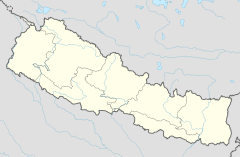Halesi-Maratika Caves
It has been suggested that Halesi Mahadev Temple be merged into this article. (Discuss) Proposed since September 2018. |
| Halesi-Maraktika Caves | |
|---|---|
 The main Halesi-Maratika Cave (aka Halesi Mahadev Temple) | |
| Religion | |
| Affiliation | Hinduism |
| District | Khotang |
| Deity | Mahadev |
| Location | |
| Location | Mahadevasthan |
| State | Province 1 |
| Country | Nepal |
| Geographic coordinates | 27°11′24″N 86°37′21″E / 27.19006°N 86.622391°E |
| Architecture | |
| Type | naturally formed |
The Halesi-Maratika Caves are located next to the village of Mahadevasthan, in the Khotang District of Nepal, about 185 km south west of Mount Everest. They are a venerated pilgrimage site for Hindus and Himalayan Buddhists. The caves are called the Halesi Mahadev Temple by Hindus who and associate them with Mahadeva, a form of Shiva; while Buddhists consider them to be the Maratika caves associated with the legend of Padmasambhava.
In Buddhism
Mandarava and Padmasambhava realised a number of terma that had been elementally encoded as terma in Maratika Cave by Dakini Sangwa Yeshe, terma that number among the longevity teachings of Buddha Amitabha and given at the behest of Bodhisattva Avalokiteswara. At Maratika Cave, Mandarava and Padmasambhava attained the Vidyadhara of longevity or long life.
Original sources
According to current scholarship[who?], the caves of Maratika are referred to in Himalayan literature from the 12th century. Kathang Zanglingma, a biography of Padmasambhava, a terma revealed and transmitted by Nyangrel Nyima Ozer, describes the original events which made the Maratika caves a sacred place for Vajrayana practitioners.
Haleshi Mahadeva or Maratika Cave- The famous natural cave in Khotang District, said to be the abode of Mahadeva while hiding away from the monster Bhasmasur. It is famous pilgrimage centre in east Nepal for both Hindus and Buddhist and is also nicknamed as 'the Pashupatinath of the east'. Huge religious fairs are observed here on Shivaratri and Bala Chaturdashi.
Further reading
- Buffetrille, Katia (2012). "Low Tricks and High Stakes Surrounding a Holy Place in Eastern Nepal: The Halesi-Māratika Caves". In Buffetrille, Katia (ed.). Revisiting Rituals in a Changing Tibetan World. Brill's Tibetan Studies Library. Vol. 31. Leiden / Boston: Brill. pp. 163–208. ISBN 9789004232174. ISSN 1568-6183.
{{cite book}}: External link in|chapterurl=|chapterurl=ignored (|chapter-url=suggested) (help)
- Buffetrille, Katia (1994). The Halase-Maratika Caves (Eastern Nepal): A sacred place claimed by both Hindus and Buddhists. Pondy Papers in Social Sciences. Vol. 16. Pondicherry: Institut Français de Pondicherry.

